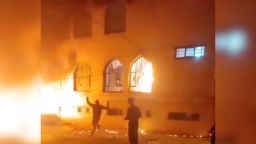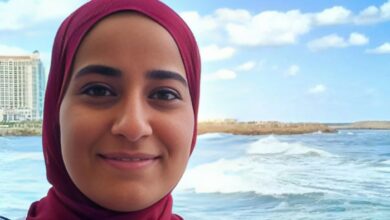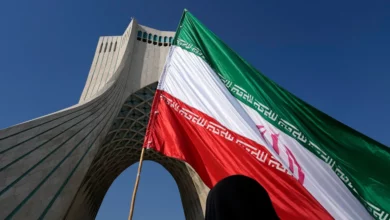
Children stand at the front of the courthouse protest chanting “No to execution” in a January 14 video shared by the Human Rights Activists News Agency (HRANA). Despite the blurring of faces in the video, one girl can be seen wiping her tears. She appears no older than 10 years.
The nationwide uprising that began in mid-September convulsed Iran, posing the biggest domestic threat to the ruling clerical class in more than a decade.
It penetrated the regime’s conservative support base and produced countless acts of defiance – and sometimes violence – against the formidable Basij, a voluntary paramilitary group that is the fulcrum of the Islamic Republic’s security apparatus. The protesters were young and angry, and a barrier of fear appeared to have broken.
Four months on, the protests have fizzled out amid a growing wave of repression against demonstrators. Four protesters have been executed by the regime; many others fear the same fate. The executions are the culmination of an increasingly violent crackdown including the gunning down of protesters, mass arrests, physical assault and sexual violence.
The regime has also doubled down on the repression of dissidents, ethnic minorities and women. Iran’s Supreme Leader Ayatollah Ali Khamenei has chalked the protests up to a foreign conspiracy and has called them an “act of treason.”
Another factor working against the protesters: most people over the age of 25 have steered clear of the demonstrations, analysts and activists said. This deprived the protest movement of the momentum needed to topple a heavily sanctioned regime over which the international community has little to no remaining leverage.
Still, Iran analysts agree that the regime has kicked the can down the road, and that protests are likely to resurface. Iran’s clerical leadership is either unwilling or unable to address its festering economic problems, exacerbated by a US sanctions regime and by widespread corruption.
“People’s anger has increased, not decreased,” said a 25-year-old activist from the southeast of the country who asked not to be named due to concern for his safety. “If there were no guns in the hands of security forces, large masses of people would stage an insurrection tomorrow.”
Almost 20,000 people have been arrested according to activists. More than 500, including dozens of children, have been killed, according to HRANA.
The repressive methods have left Iran’s protesters in a catch-22 situation. Disgruntlement against the regime appears to be spreading, but its use of brute force has deterred protesters from growing to the level needed to force the regime to stand down.
The absence of a critical mass created a “mathematical problem” for the protest movement, said Ali Vaez, International Crisis Group’s Director of the Iran Project.
“The majority will only join in when the regime has lost its will to suppress,” he told CNN. “And the regime’s will to suppress is unlikely to crack unless there is a critical mass on the streets.”
Vaez compares the state of affairs in Iran to the Soviet Union in the early 1980s, a period of public frustration and dire economic conditions that years later prompted the string of reforms, known as Perestroika, that preceded the USSR’s collapse.
“(The Islamic Republic) is where the Soviet Union was in early 1980s … It is ideologically bankrupt, is economically in deep trouble and is simply unable to reform itself,” said Vaez. “Unlike the Soviet Union in the late 1980s, (Iran) still has the will to fight.”
“One can conclude that the protests will re-emerge sooner rather than later in a more ferocious manner,” he added.
The chilling effect of executions
Echoes of the uprising continue to reverberate in the country. Every night in Tehran, , chants of “death to the dictator” ring out from rooftops and from behind drawn curtains, out of the sight of security forces. Anti-regime protests continue to crop up in some of the country’s minority-dominated border regions which bore the brunt of the regime’s crackdown.
On Friday, thousands of people poured into the streets of Baloch-majority Zahedan city after noon prayers, demanding the fall of the regime.
The Kurdish-majority west of the country continues to be peppered by gatherings marking the end of 40-day mourning periods for slain protesters.
“Kurdistan, Kurdistan, the graveyard of fascists,” mourners chanted in a video shared by Iranian-Kurdish human rights group Hengaw on January 16. The mourners raised roses in the air to commemorate Hooman Abdullahi, a protester who was shot and killed by security forces.
For activists, the endurance of the protests among ethnic minorities is a sign of what’s to come. The executions, they say, will eventually backfire.
At least 18 protesters have been sentenced to death as of now, with only five having won the right to appeal, according to HRNA. More than 100 protesters have been charged with crimes that carry the death penalty.
Four people have been executed already, including high-profile prisoners such as a karate champion and children’s coach.
“People are more angry after we realized how fast and hastily they hanged those men,” said one activist in Iran who does not want to be identified for security reasons and calls himself Mr. Z. “I think they compressed the spring more. Next time, people won’t even be afraid of being hanged,” he told CNN.
The executions have drawn sharp condemnation from the international community. Reports, including CNN’s own reporting, suggest that most protesters are being denied due process, with speedy trials and access only to state-appointed lawyers.
But the death sentences have also had a chilling effect, mostly on the older generation of Iranians who largely stayed off the street and who are now trying to keep their children at home, activists say.
“Nobody wants to hold a picture of their kid,” said one activist outside Iran, referring to mothers carrying photos of their slain and arrested sons and daughters. The images have been ubiquitous since the start of the protests.
“But the kids want to build their future,” said the activist, known as Mamlekate, who has played a key role in distributing photos and video from the protests, and in connecting journalists to sources in the country.
“If the kids don’t do it, who’s going to do it?” he told CNN. “This is far from over.”





